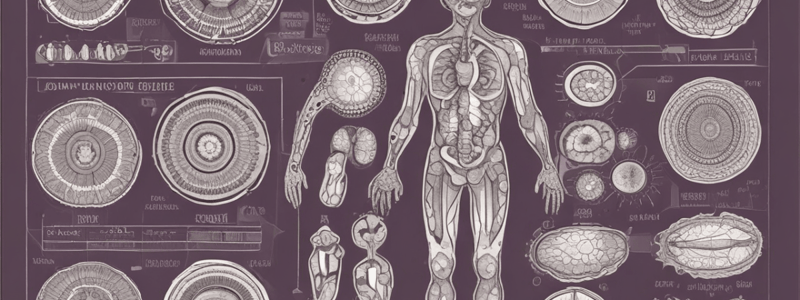Podcast
Questions and Answers
Which term describes a position farther from the midline of the body?
Which term describes a position farther from the midline of the body?
What organs are housed in the thoracic cavity?
What organs are housed in the thoracic cavity?
Which of the following is not a structural unit of the human body?
Which of the following is not a structural unit of the human body?
Which system is responsible for digestion in the body?
Which system is responsible for digestion in the body?
The femur is a bone found in which part of the body?
The femur is a bone found in which part of the body?
Which region is located in the upper left area of the abdomen?
Which region is located in the upper left area of the abdomen?
What is the primary function of the respiratory system?
What is the primary function of the respiratory system?
Which organ system is responsible for controlling and coordinating the body's activities?
Which organ system is responsible for controlling and coordinating the body's activities?
Which region of the abdomen is located in the upper middle area?
Which region of the abdomen is located in the upper middle area?
Which bone is found in the forearm?
Which bone is found in the forearm?
Flashcards are hidden until you start studying
Study Notes
Human Body Structure
The human body is a complex and fascinating organism that has evolved over millions of years to perform various tasks necessary for survival. Understanding its basic structure helps us appreciate how it functions and what can go wrong when health problems arise. In this article, we explore different aspects of the human body's structure, from cells to systems and organs.
Cellular Level
Cells are the fundamental units of life. There are two main types of cells: prokaryotic and eukaryotic. Prokaryotes lack a nucleus and other membrane-bound organelles, while eukaryotes have well-defined boundaries between cellular compartments. Humans consist primarily of eukaryotic cells, which come together in tissues, organs, and systems that work together to maintain life.
Organ Level
Organs are groups of specialized cells that work together to perform specific functions in the body. Examples include organs such as the heart, liver, and kidneys. Each organ is part of a system that performs a specific function. For instance, the cardiovascular system consists of the heart and blood vessels, which work together to transport oxygen and nutrients throughout the body.
Organ System Level
Organ systems are groupings of organs that work together to perform specific tasks. These include:
- Circulatory System: This system is responsible for transporting oxygen, nutrients, waste, and hormones throughout the body.
- Digestive System: This system processes food to extract nutrients and eliminate waste products.
- Endocrine System: This system produces hormones that regulate various bodily functions and help to maintain a stable internal environment.
- Nervous System: This system coordinates responses to internal and external stimuli through processes such as sensation, perception, and voluntary movement.
- Integumentary System: This system protects the body from injury and infection, and also helps regulate body temperature and maintain water balance.
- Respiratory System: This system facilitates the exchange of oxygen and carbon dioxide between the lungs and the environment.
- Urinary System: This system helps eliminate waste products from the body by producing, storing, and eliminating urine.
- Muscular System: This system generates force and motion by contracting and relaxing muscles.
- Skeletal System: This system provides support and structure for the body, protects vital organs, and helps to maintain proper posture.
- Reproductive System: This system is responsible for the production of offspring and the perpetuation of species.
Tissue Level
Tissues are groups of similar cells that work together to perform a specific function. There are four main types of tissues:
- Epithelial Tissue: This tissue covers and protects internal organs and serves as a barrier against infection.
- Connective Tissue: This tissue supports and connects various structures in the body.
- Muscle Tissue: This tissue is responsible for movement and maintaining posture.
- Nervous Tissue: This tissue allows for the transmission of nerve impulses throughout the body.
Overall Structure
In summary, the human body is composed of cells, which group together to form tissues, which in turn form organs. These organs work together in systems to perform various functions necessary for life. Understanding the structure and function of these components is crucial for maintaining health and diagnosing and treating diseases.
Studying That Suits You
Use AI to generate personalized quizzes and flashcards to suit your learning preferences.





